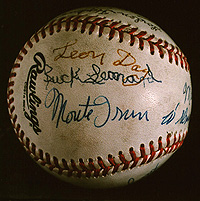Negro Leagues players with Leon Day, Monte Irvin, Buck Leonard, et al / BAS875-3-8

Upper panel
Ball type: Rawlings Official National League, single-stitched, Bill White signature.
Signatures: Fifteen, in ballpoint. Back panel (sweet spot): Max Manning, Red Fields. Upper panel: Leon Day, Buck Leonard, Monte Irvin. Right side panel: Leroy Ferrell, Bill Owens, Mahlon Duckett, Larry Kimbrough. Lower panel: Stanley Glenn, Wilmer Harris. Left side panel: Gordon Hopkins, Jim Cohen, Al Wilmore, Gene Benson.
Condition: All signatures fully discernable, with no evident fading. Ball slightly soiled; no natural discoloration.
Notes: From the late nineteenth century until shortly after World War II, an unwritten yet strictly observed "gentlemen's agreement" excluded men of color from the teams and leagues that made up organized baseball. As a consequence, many of the country's finest players had no alternative but to join segregated "colored" clubs, where they plied their trade in relative obscurity, unknown to the majority of Americans. In the early years of the Jim Crow era black clubs operated independently, outside any league structure. This changed in 1920 with the organization of the first of the "Negro Leagues," Rube Foster's National Association of Professional Base Ball Clubs, better known as the Negro National League. The NNL included top teams from around the Midwest, almost all of them under black management; it enjoyed some initial success but could not survive Foster's death and the onset of the Depression. Other elite black leagues operated in the 1930s and '40s, most notably a revival of the NNL and the new Negro American League, formed in 1937. But even in the years when a substantial league structure existed, clubs found it financially necessary to play a majority of games on the barnstorming circuit, taking on a broad array of professional and semi-professional competition, white and black, in towns across the nation. In the world of black baseball, itinerancy was the key to survival: the capital necessary to finance a club existed primarily in Northern cities, while most blacks lived in the South. Barnstorming teams would often inject elements of clowning or showmanship into their performances - though the extent to which this was done varied greatly from club to club, and also depended on the opponent. The organized Negro Leagues drew unprecedented crowds during World War II, but the signing of Jackie Robinson by the Brooklyn Dodgers ensured that black baseball as an institution would not last. The NNL collapsed in 1948, while the NAL survived the '50s as a four-team league, filling out its rosters with teenagers and second-line talent.
All of the players whose signatures appear on this ball were members of elite black teams, mostly in the years around World War II. Of the sixteen representatives of black baseball currently in the Hall of Fame, three are present. Leon Day was a very hard-throwing right-handed pitcher (and sometime position player) who spent much of his career with the Newark Eagles of the NNL; he and Satchel Paige are generally regarded as the best black hurlers of the era just prior to integration. Buck Leonard was a slugging first baseman for the Homestead (Pa.) Grays for seventeen seasons (1934-50), who teamed with catcher Josh Gibson to give the Grays one of the best offensive twosomes in the game's history. Monte Irvin was a fine outfielder for the Newark Eagles from 1937-42 and 1945-48; alone among the players on this ball, Irvin received the opportunity to play in the major leagues, and starred for the New York Giants in the early 'fifties. Less well known than these Hall-of-Famers, but excellent performers in their own right, were pitchers Red Fields and Max Manning, center fielder Gene Benson, and shortstop Bill Owens (a representative of a slightly earlier era, whose career spanned the years 1923-33). The signatures on the ball date from the early 1990s, and were probably obtained at one or more memorabilia shows or Negro Leagues reunions.
Provenance: Purchase, 1997.
General RBSC Hours
- Mon - Fri
- 9:30am - 4:30pm
- Sat - Sun
- CLOSED
For exceptions and Hesburgh Library information, view All Library Hours

 |
| 